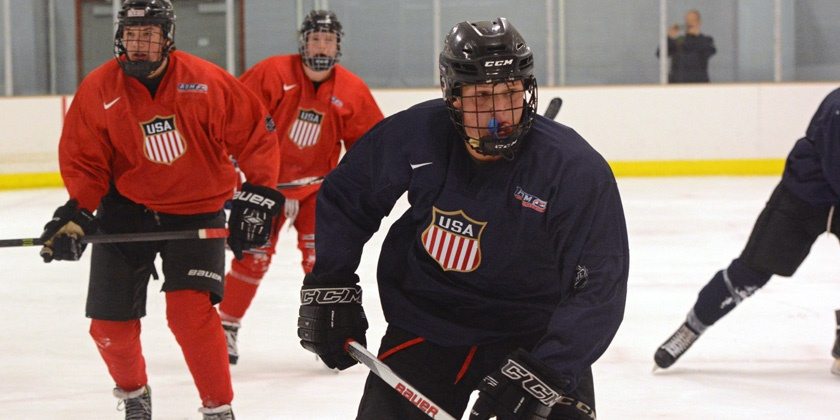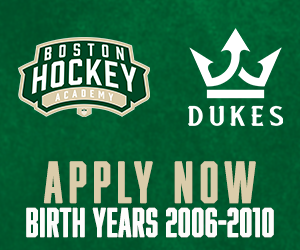More than at any other point in history, the hockey landscape facing today’s generation of amateur players is defined by an ultra-competitive, accelerated, and stop-at-nothing culture where players and families are making incredible – and often senseless – sacrifices all for the “chance” at an NCAA scholarship or CHL contract.
In today’s game, players at the ages of 13 and 14 are signing with agents (commonly referred to as Family Advisors), leaving home to billet with families to play on top bantam and midget programs, and even visiting college campuses and committing to schools. In Ontario, families are moving closer to Toronto or buying apartments in the city so their children can play in the top league, the GTHL, where they’ll get the best coaching and exposure to OHL scouts.
The accelerated growth track that high-level hockey has been on in recent years has hit every section of the country. Non-traditional hockey markets are having a tough time holding onto their kids because there often isn’t enough competition or depth to challenge them. The talent level in high school hockey, even among the major hockey hotbeds like Minnesota, Michigan and Massachusetts, has plummeted as the top prospects are leaving early for junior hockey.
Massachusetts and Michigan have seen their once prestigious high school hockey traditions take a major talent hit as the new age of elite players rarely graduate from these schools – if they even attend them at all. These players are being scouted by midget, prep and junior teams from all over the US and Canada, and if given the opportunity, are fleeing the high school scene.
There may not be a league more that has been more impacted by this phenomenon in recent years than Minnesota high school hockey, one of the most storied hockey traditions in the country at any level. Minnesota high school hockey has produced some of the best American born players in the history of the NHL, and has long been a primary recruiting ground for junior teams from both the U.S. and Canada. For the past six years the league has been losing on average about 25 players per year but that number spiked in 2014 to 41.
However, a potential new pattern, one which goes against the grain and may bring this entire scenario full circle, may be starting to emerge in Minnesota. If it proves to be more than just an anomaly, it will certainly be cause for celebration among fans and advocates of Minnesota high school hockey, and could also pave the way for similar trends in other areas of the country as well.
The pattern we’re pointing to is that of committed, high-level talents deciding NOT to leave high school early in pursuit of junior hockey.
Riley Tufte, the top NHL prospect in Minnesota this past season, shocked many when he opted out of playing a full season with the Fargo Force of the USHL in order to return home to Blaine and finish his high school hockey career. This came after Tufte had played with the Stars throughout the fall months.
This USHL split-season trend for high-end Minnesota high school prospects may continue to grow going forward, and another example of this potential pattern is Casey Mittelstadt, arguably the best prospect overall in Minnesota right now. Mittelstadt announced he will return to Eden Prairie to complete his senior year, but will play for the Green Bay Gamblers of the USHL before and after his high school season.
Two examples for consideration regarding this scenario – as well as the constant debate about whether players should stay at their current level or leave for stronger competition and development – are two high end Minnesota HS players: Riley Tufte and Jake Jaremko. Tufte’s NHL draft ranking remained at 17 between both the NHL Central Scouting midterm and final pre-draft rankings. At least for Tufte, returning to play high school hockey in his home state certainly did not hurt his NHL draft stock. The “draft stock” argument is one that is often used among junior and NHL scouts who tell high school and even prep players that their draft stock will be negatively impacted by playing in lower level competition. This was the case with Jake Jaremko who decided to stay in Minnesota HS for four years at Elk River instead of joining the USHL. Despite averaging almost 3 points per game in his senior year he was not drafted. This season, he played for the Chicago Steel and was their best forward, leading scorer and captain. He will head to Minnesota State.
Given both the prevalence and complexity of the “stay versus go dilemma” for different players across the country, Neutral Zone decided to touch base with Mittelstadt to gain a better understanding of what factors played into his decision to return to Minnesota high school hockey, and also to learn more about his development and college recruiting process.
NZ: Tell us about your college recruiting process? Obviously you were a heralded player in the state of Minnesota but when was it that schools began reaching out? What other schools showed interest? How difficult was that decision for you to make?
Mittelstadt: My recruiting process was really quick! I started being recruited during August of the summer going into my 10th grade year, and when the University of Minnesota began talking to me it was an easy decision for me.
NZ: Tell us about this past season. You made the jump from one of the top players in your state to one of the top players in the country. What do you attribute your recent success to?
Mittelstadt: I think the main thing for me is just having a consistent work ethic and doing something every day to get better. Shooting pucks and lots of stick handling helped me get better really quick.
NZ: After your high school season you joined the NTDP program for 13 games and performed really well. You also had the opportunity to play in the U18 World Championships. What were those experiences like and what did you take away from them?
Mittelstadt: It was a lot of fun. I grew up playing with a lot of those guys so it was fun to catch up and also fun to meet some new guys.
NZ: Talk about the Minnesota state tournament and what it was like to make it all the way to the championship game last year.
Mittelstadt: It’s a special weekend and a dream come true, but coming up short still hurts every day and it motivates me to get better so that doesn’t happen again.
NZ: Obviously Minnesota high school hockey is sacred to the fans across the state. However, in the hockey world, there is a lot of pressure for players to go to college early, or leave high school or midgets and join junior teams to improve their NHL draft stock, NCAA recruiting favorability etc. Talk about your decision to stay home next year instead of matriculating at the University of Minnesota or playing a full season in the USHL. What factors were a part of the decision, was it difficult, and why did you ultimately make the decision you made?
Mittelstadt: There’s a lot of pressure to leave Minnesota because people say the hockey isn’t good enough, but I think the hockey is great and still growing. Once you play in the state tournament it’s very hard to leave because you realize how special it is to be a part of.
NZ: After what you have been through both on and off the ice over the past three seasons, what would your advice be to the up and coming bantams playing in Minnesota next year who are starting to get some attention from colleges and junior teams?
Mittelstadt: I would say never take one game or practice for granted. I played my last game back on March 5th with some of best friends since I was 7 or 8. It’s a special thing to grow up and Minnesota and never take any time at the rink with your best friends for granted.
NZ: Riley Tufte took a similar route in staying back and playing Minnesota HS in his draft year. Did you ever talk to him about his experience or seek advice?
Mittelstadt: Yeah we’re pretty good friends. We talked about it A little bit, he told me he never regretted his decision and that helped me realize that you’ll never regret coming back your senior year.
Photo Credit: Dan Hickling/Hickling Images





